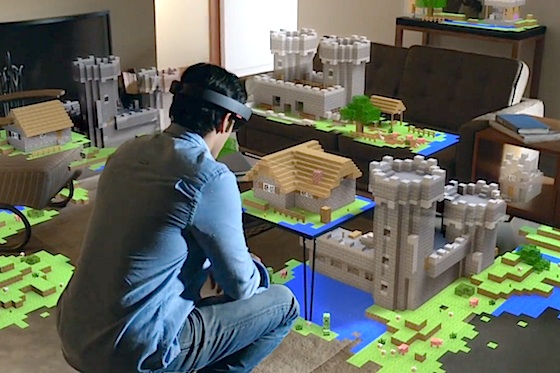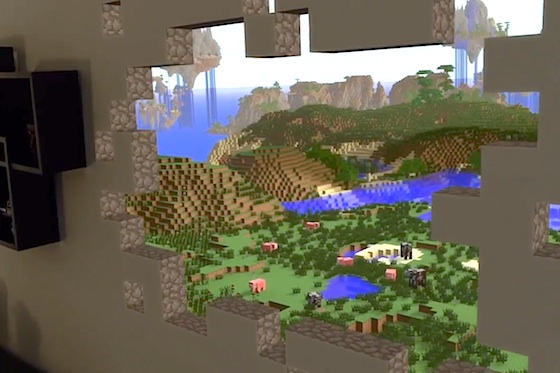Sure, the video shows some gimmicky features that no one will ever use. C'mon, who wants to see 3D weather forecast icons on their kitchen table? No one. But a virtual TV on the wall? Intriguing. Could the TV set be the one of the items we drop in favor of holographic glasses? Now, a pair of glasses only serves one viewer while a single TV set can be seen by many. But the flexibility of a TV "screen" that moves around with you might prove more alluring than buying multiple sets, especially in a home with smaller families who can afford a pair of glasses for everyone.
A reporter from Wired spent some time last fall testing the glasses and came away impressed. These aren't the weak, and now discontinued, Google Glass. Microsoft's partnering with Pasadena's JPL to use the HoloLens for analysis of Mars rover data, by creating a 3D holographic space for scientists to explore. But it's Microsoft's illustration of how HoloLens could expand the Minecraft experience should get theme park fans thinking.

Holographic technology provides theme park designers with the opportunity to more seamlessly blend practical and virtual space. Designers have been putting screens together with practical effects in award-winning rides such as Universal's Transformers: The Ride and Disney's Mystic Manor. Holograms would allow designers to take that relationship to another level. Imagine what a theme park attraction could look like if we dropped today's 3D glasses in favor of tomorrow's HoloLens.
Of course, new technology creates challenges as well as opportunities. Virtual reality gear such as HoloLens create an individual experience, often in a fixed location. They typically just simulate the experience of being in a physical space with other people. Yet theme parks do much the opposite. They put people in close proximity with one another in practical spaces through which the park would really like people to keep moving.
So creating a compelling HoloLens-powered theme park attraction isn't as simple as putting a few demo models in Innovations (though, hey, at this point, many of us would be perfectly happy if Disney just did that). A great HoloLens-driven attraction would play to the relatives strengths of the technology and the parks that would house it.
We don't need HoloLens to help us interact with the people who already surround us in a theme park. But it would be a wonderful new way for us to interact with the characters that cannot be there in "real," practical form. Imagine the Genie from Disney's Aladdin show rendered as an animated hologram rather than a physical character who by that nature cannot morph his form the way that an on-screen animated character can. In holographic form, he could.
A compelling animated holographic character could help drive parks' need to move people through the physical space of an attraction by serving as a guide who draws us to follow. Imagine how much more amazing Universal Orlando's Poseidon's Fury walk-through show could be if it used HoloLens as the platform for its characters, whom we would follow through the show space.
Parks also could use holographic technology to complement practical sets to expand the visual range of an attraction's setting. Think of how Microsoft showed how HoloLens could allow viewers to see the Minecraft universe breaking through physical walls in a living room.

Imagine SeaWorld taking another crack at its Antarctica ride, but instead of confining us in those penguin-less caves for the first two scenes in the ride, we were whisking through the vast outdoor Antarctic wilderness which SeaWorld would create in holographic form. With holograms, a park could save on the expense of building and maintaining massive projection systems to create screen-based environments, building only suitable surfaces upon which we would see the holograms projected inside our glasses, with enough practical setting to help sell the illusion.
Sure, we've got questions: How much will holographic development cost? We're not just talking labor hours to design and program systems, we're talking about creating the server and network capacity to support multiple, moving wireless glass units in a defined attraction space, too. When might parks (and consumers) be able get these glasses, and at what price? In the short run, it's almost certain that existing technology will prove less expensive for parks to create screen-based attractions. But in a few years? Who knows?
And, ultimately, can Microsoft deliver? If you're skeptical that the company behind Windows and Office programs might be able to pull this off, remember that this is the company behind Xbox and Kinect, too, which might be more relevant technology to what HoloLens seeks to do.
So let's get dreaming here. Do you think that HoloLens could drive a compelling theme park attraction? If so, how would you like to see theme parks use HoloLens in the parks?
You also might like:
This article has been archived and is no longer accepting comments.